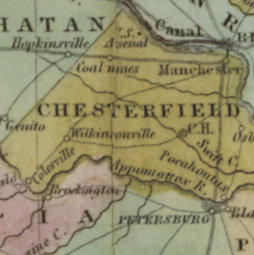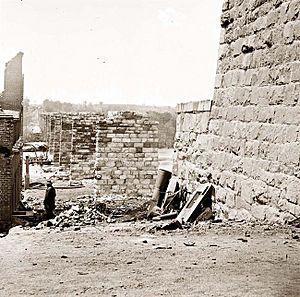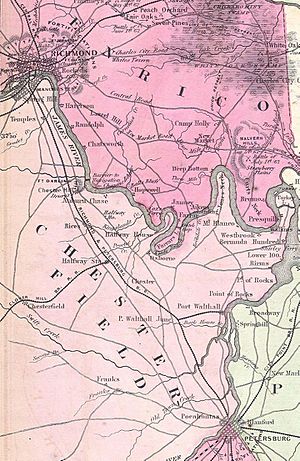Richmond and Petersburg Railroad facts for kids
| Overview | |
|---|---|
| Headquarters | Richmond, Virginia |
| Locale | Virginia |
| Dates of operation | 1838–1898 |
| Successor | Atlantic Coast Line Railroad |
| Technical | |
| Track gauge | 4 ft 8 1⁄2 in (1,435 mm) standard gauge |
| Previous gauge | previous gauges: 5 ft (1,524 mm) and 4 ft 9 in (1,448 mm) |
| Length | 22 miles (35 km) |
The Richmond and Petersburg Railroad was a train line that carried people and goods between the cities of Richmond and Petersburg in Virginia. It operated from 1838 to 1898. This railroad survived the American Civil War and later joined with the Atlantic Coast Line Railroad in 1900.
Contents
History of the Railroad
The Richmond and Petersburg Railroad started in 1836 and was sold in 1898. It went through a major war and several financial problems. This railroad grew from just connecting two cities to becoming part of a larger train system along the East Coast. It also changed from using enslaved workers to having fully paid employees.
How the Railroad Started
In 1836, the government of Virginia allowed a new railroad to be built between Richmond and Petersburg. This railroad would connect to other lines, helping to transport cotton and coal to markets. Moncure Robinson, a famous engineer, designed the Richmond and Petersburg Railroad.
The train line was finished in 1838. It reached Manchester, Virginia, which was a busy industrial town across the James River from Richmond. The new steam trains passed near the end of the Chesterfield Railroad, which used mules and gravity to bring coal from Midlothian.
Building the railroad was hard because of a money crisis called the Panic of 1837. This made it difficult to get enough money for construction. However, the state of Virginia and a loan from England helped the company keep going. Many of the workers who built the railroad were enslaved people. The railroad company paid fees to the people who owned these enslaved workers and also provided clothes for them.
In 1845, a smaller train line was added to Port Walthall. From there, people and goods could travel by Steamboat to cities like Norfolk, Washington, Baltimore, and Philadelphia. The railroad also carried mail for the United States Postal Service.
Moving Coal by Train
In 1841, the Clover Hill Railroad Company was created to work with the Richmond and Petersburg Railroad. They were allowed to charge only a small fee for shipping coal. The Clover Hill Railroad started bringing coal from new mines called the Clover Hill Pits in 1848. This coal was then sent north by the Richmond and Petersburg Railroad from Port Walthall.
At first, the Clover Hill Railroad made a lot of money. However, the Chesterfield Railroad, which also moved coal, was not as fast as the new steam-powered Richmond and Danville Railroad, which reached Midlothian in 1850. Because of this, the Chesterfield Railroad was sold. The Richmond and Petersburg Railroad also lost money during this time.
Train Ticket Prices
In 1853, a ticket for the whole line cost $1.10 for white adults. African Americans and children paid 60 cents. For shorter trips, like stopping at Port Walthall Junction or Half Way, prices ranged from 35 to 85 cents for white adults, and 35 or 60 cents for African Americans.
Civil War and Rebuilding
Before the Civil War, railroads in the Southern United States were built to help local businesses. The Richmond and Petersburg Railroad even owned buses and coaches to help passengers get from one train line to another. However, connecting different train lines in cities was not very efficient. Passengers often had to stay in hotels.
Robert E. Lee, a general for the Confederate States of America, predicted that the South's unconnected railroads would cause problems for the military. He was right. During the American Civil War, two train engines had to be pulled over land around Alexandria because the tracks didn't connect.
Near the end of the war, Ulysses S. Grant, a Union general, tried to cut off the Richmond and Petersburg Railroad. This railroad was a main supply line for Richmond. As the Confederate soldiers retreated, they destroyed the bridge over the James River. The U.S. government quickly rebuilt this bridge, which was a 400-foot-long wooden bridge.
After the war, during the Reconstruction of the United States, people from outside the South began to own parts of the railroads. These new owners wanted train lines to pass through cities more easily. So, Union stations were built to connect different train lines. In 1867, a new company was formed to connect the Richmond and Petersburg Railroad with the Richmond, Fredericksburg and Potomac Railroad. Money was also invested to rebuild the Richmond and Petersburg Railroad Bridge over the James River.
By 1884, a train trip from one end of the line to the other took about an hour. A faster trip with no stops took 45 minutes. There were three passenger trains and one mail train going in each direction daily. These trains connected to other railroads like the Brighthope Railway and the Norfolk and Western Railroad.
The Richmond and Petersburg Railroad was built with a 5-foot wide track. The Brighthope Railway had a narrower 3-foot track. In 1886, railroad leaders in the South decided to make all tracks the same width. This would allow trains to travel all over the South without having to unload goods or make passengers change trains. In May of that year, the track width was quickly changed to the standard 4 feet 8.5 inches.
Before the Civil War, steam trains used wood for fuel. During the war, enslaved workers called "wood choppers" provided fuel for the Richmond and Petersburg trains. After 1870, as forests were cut down, coal became more important. By 1893, the Richmond and Petersburg Railroad hired firemen to shovel coal, and they no longer bought wood for fuel.
The Belt Line
By the late 1880s, there was a lot of train traffic in downtown Richmond. The tracks connecting to the Richmond, Fredericksburg and Potomac Railroad ran right through the middle of busy streets. To fix this, the Richmond and Petersburg Railroad and the Richmond, Fredericksburg and Potomac Railroad worked together to build a new line that went around downtown Richmond.
This new line was called the Belt Line. It opened in 1891. It connected to the main Richmond and Petersburg line and then went northwest, crossed the James River, and headed north to meet the other railroad. At first, the Belt Line had only one track and was used for freight trains, while passenger trains still used the old route through downtown.
Joining the Atlantic Coast Line
By 1882, passengers could travel easily in sleeper cars from Boston to Washington, D.C., or from New York to Jacksonville, Florida. In 1889, a company was formed that brought together five different railroads, starting with the Richmond and Petersburg Railroad. This group of railroads was later called the Atlantic Coast Line.
In 1898, the Richmond and Petersburg Railroad joined with the Petersburg Railroad to form the Atlantic Coast Line of Virginia. By 1900, all five railroads had merged to create the large Atlantic Coast Line Railroad, which stretched from Richmond all the way to Augusta, Georgia.
After joining the Atlantic Coast Line, the old Richmond and Petersburg line became the northern part of the Atlantic Coast Line's main route. In 1916, the Atlantic Coast Line and the Richmond, Fredericksburg and Potomac Railroad built a new train station together called Broad Street Station. Passenger trains then started using the Belt Line to reach this new station. The Belt Line was made into a double track, and a new arch bridge over the James River was finished in 1919.
In 1967, the Atlantic Coast Line merged with another railroad, the Seaboard Air Line Railroad. The new company was named the Seaboard Coast Line Railroad. Later, in 1980, this company joined with the Chessie System to form the CSX Corporation. Today, the old Richmond and Petersburg line is still used by Amtrak and CSX.
Railroad Leaders
Here are some of the people who led the Richmond and Petersburg Railroad:
- W. H. McFarland
- Wirt Robinson (starting 1851 or earlier)
- Holden Rhodes
- Charles Ellis (1860 or earlier – 1870)
- Thomas H. Wynne (starting 1870)
- Frederick R. Scott (1874 – 1898)
Train Cars
In 1893, the Richmond and Petersburg Railroad had 10 locomotives (the engines that pull the train), 7 passenger cars, 3 baggage cars, 71 freight cars (for goods), and 6 other cars, including cabooses.
The locomotives and passenger cars had special Janney couplers that connected them automatically. Other cars used different types of automatic links. The locomotives had automatic brakes, passenger cars had air brakes, and other cars used hand brakes.
Railroad Employees
Before the Civil War ended, many of the workers on the railroad were enslaved people. In 1864, 118 enslaved people worked on the railroad, while there were only 78 paid employees.
Enslaved workers drove buses and wagons, worked in repair shops, helped in offices, and worked at stations. They also worked as firemen and train hands, repaired tracks, shoveled gravel, and chopped wood for fuel. Paid employees managed the enslaved workers and included skilled workers like copper smiths, carpenters, and painters. They also worked as inspectors, ticket agents, clerks, and company officers. The railroad company owned one enslaved person in 1858 and rented others.
After the war, all employees were paid. By 1893, the railroad had ten main officers and 32 men working at stations. There were ten enginemen who drove the trains, 13 firemen who shoveled coal, and six conductors who kept trains on schedule. Nineteen other men worked on the trains.
In the shops, five machinists and five carpenters worked with six other shopmen. On the tracks, there were four section foremen, eight other trackmen, and 44 flagmen, watchers, and switchers. Telegraph operators sent messages along the tracks. Nearly one hundred other laborers also worked for the railroad.
Working on the trains was dangerous. In 1893, eight train workers were killed, and two were injured. Two other employees, three passengers, and two people not on the train were also injured.
Passengers and Goods
The trains carried hundreds of thousands of passengers each year. The freight cars shipped many different goods, including:
- Lumber
- Fruits and vegetables
- Tobacco
- Grain and flour
- Hay
- Iron
- Cement and brick
- Lime
- Coal
- Meat, poultry, game, and fish
- Cotton, wool, and leather
- Wine, liquor, and beer
- Wagons and carriages
- Farm tools and other tools
- Iron rails and boat parts
Train Stations
Here are the main stations along the Richmond and Petersburg Railroad lines:
Main Line
| Milepost | City/Location | Station | Connections and notes | |
|---|---|---|---|---|
| AR 0.0 | Richmond | Byrd Street Station | connected with the Richmond, Fredericksburg and Potomac Railroad | |
| Bridge over James River | ||||
| AR 1.6 | Manchester | connected with the Richmond and Danville Railroad | ||
| AR 3.3 | Clopton | |||
| AR 5.0 | Temple's | |||
| A 5.5 | FA Junction | connected with the Belt Line | ||
| A 5.9 | Falling Creek | |||
| A 8.7 | Drewry's Bluff | also known as Bell Bluff | ||
| A 10.7 | Centralia | |||
| A 11.0 | Half Way Station | A stop where trains could get water | ||
| A 12.8 | Chester | connected with the Richmond, Petersburg and Carolina Railroad | ||
| A 13.2 | Clover Hill Junction | connected with the Clover Hill Railroad | ||
| A 17.0 | Walthall | originally called Port Walthall Junction | ||
| A 19.4 | Dunlop | |||
| Bridge over Appomattox River | ||||
| A 22.0 | Petersburg | Petersburg | Later replaced by Petersburg Union Station in 1910, and then by the current station in 1955. Connected with the Petersburg Railroad and the Southside Railroad. | |
Belt Line
| Milepost | City/Location | Station | Connections and notes |
|---|---|---|---|
| Richmond | Broad Street Station | Opened in 1917, located on the Richmond, Fredericksburg and Potomac Railroad | |
| ARN 3.6 | AY Interlocking | Connected with the Richmond, Fredericksburg and Potomac Railroad | |
| ARN 0.0 A 0.0 |
Bridge over James River | ||
| A 1.0 | Meadow | ||
| A 5.5 | FA Junction | Connected with the Main Line | |








